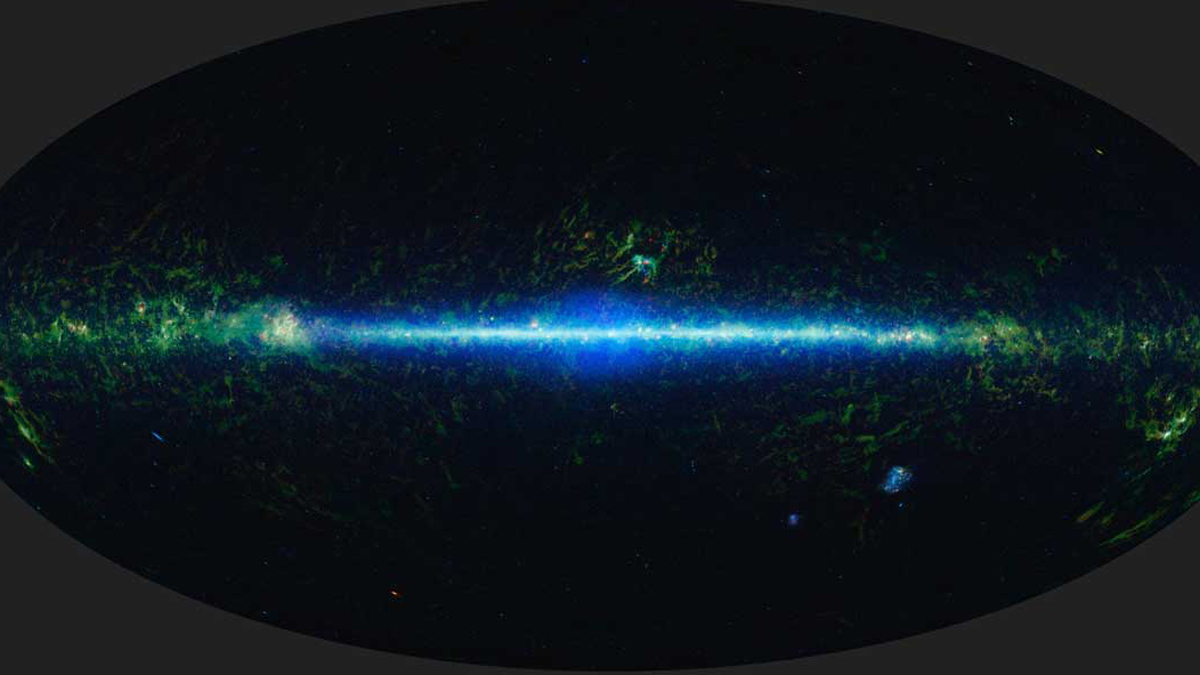Stunning time-lapse video reveals a decade in the life of the universe
NASA's WISE mission hasn't let a lack of coolant slow down its infrared observing schedule.
Black holes gobbling gas, baby stars emerging within thick dust shrouds and old stars exploding in powerful supernovas: these are just a few of the types of events witnessed in a decade by NASA's asteroid and comet explorer NEOWISE and released in a stunning new video.
NASA's NEOWISE, or Near-Earth Object Wide Field Infrared Survey Explorer, orbits about 300 miles (500 kilometers) above Earth, constantly facing the sky and gazing into the universe. Every six months, the telescope completes a portrait of the entire cosmos that is visible to its infrared detectors. By arranging 18 of these portraits into a sequence, astronomers have created a movie depicting a decade in the life of stars, galaxies and other objects within the telescope's reach.
NEOWISE is an extension of the WISE (Wide-field Infrared Survey Explorer) mission, which launched in 2009. WISE, designed to look beyond our solar system, ran out of the coolant it required to maximize the sensitivity of its detectors in 2011. Since the spacecraft was still in good health and two of its four infrared detectors remained functional at warmer temperatures, NASA repurposed the mission to focus on closer objects, mostly comets and asteroids orbiting the sun.
Related: Largest-ever map of 56,000 galaxies is demystifying the universe's expansion

The telescope has been scanning the sky with renewed vigor under the new name, NEOWISE, since 2013 and has greatly exceeded the astronomers' expectations. The last decade of work has proved that even without the coolant, the spacecraft's detectors are still powerful enough to peer far beyond the solar system.
This 12-year timespan of NEOWISE observations, as captured in the video, reveals a lively, blinking field of stars, comets, asteroids, planets, galaxies and black holes. Overall, NEOWISE maps showcase hundreds of millions of objects inside and outside of our Milky Way galaxy.
"If you go outside and look at the night sky, it might seem like nothing ever changes, but that’s not the case," Amy Mainzer, principal investigator for NEOWISE at the University of Arizona in Tucson, said in a statement Tuesday (Oct. 18). "Stars are flaring and exploding. Asteroids are whizzing by. Black holes are tearing stars apart. The universe is a really busy, active place."
Get the Space.com Newsletter
Breaking space news, the latest updates on rocket launches, skywatching events and more!
Being an infrared telescope, just like the bigger NASA James Webb Space Telescope that entered operations this year, NEOWISE detects the heat emitted by celestial objects. Infrared vision is a sort of a superpower that allows telescopes to see what is invisible to telescopes detecting optical wavelengths (the same wavelengths that are visible to the human eye). With infrared vision, telescopes can peer through thick clouds of gas and dust into regions where stars and planets form, allowing astronomers to witness these special events in real time. Although much less powerful than the great Webb, NEOWISE could, nevertheless, observe about 1,000 nascent stars.
The telescope has also made leaps in the research of brown dwarfs. Sometimes called failed stars, brown dwarfs are dim objects that are too big to be planets, but not large enough to ignite nuclear fusion in their cores like stars. NEOWISE sees brown dwarfs within about 70 light-years of the sun. Astronomers discovered over 200 hundred of them in the sun's vicinity, which helps them gauge the efficiency of star formation in our galaxy.
The telescope also hunted down supermassive black holes at the center of other galaxies. Using the telescope's data, scientists could devise a new technique for measuring the size of the disks of gas falling into distant black holes, which are not bright enough to be visible to other telescopes.
"We never anticipated that the spacecraft would be operating this long, and I don’t think we could have anticipated the science we’d be able to do with this much data," Peter Eisenhardt, an astronomer at NASA’s Jet Propulsion Laboratory and WISE project scientist said in the same statement.
Follow Tereza Pultrova on Twitter @TerezaPultarova. Follow us on Twitter @Spacedotcom and on Facebook.
Join our Space Forums to keep talking space on the latest missions, night sky and more! And if you have a news tip, correction or comment, let us know at: community@space.com.

Tereza is a London-based science and technology journalist, aspiring fiction writer and amateur gymnast. Originally from Prague, the Czech Republic, she spent the first seven years of her career working as a reporter, script-writer and presenter for various TV programmes of the Czech Public Service Television. She later took a career break to pursue further education and added a Master's in Science from the International Space University, France, to her Bachelor's in Journalism and Master's in Cultural Anthropology from Prague's Charles University. She worked as a reporter at the Engineering and Technology magazine, freelanced for a range of publications including Live Science, Space.com, Professional Engineering, Via Satellite and Space News and served as a maternity cover science editor at the European Space Agency.









